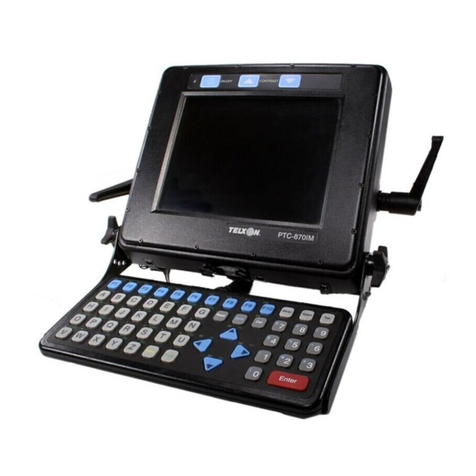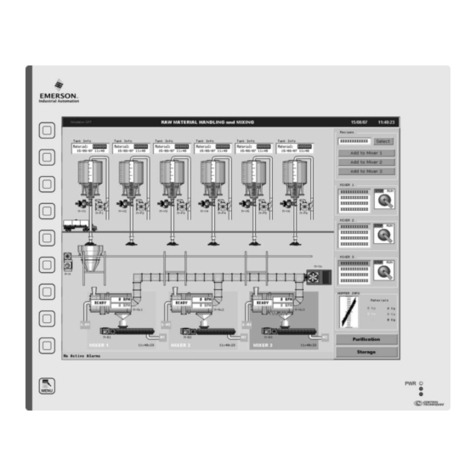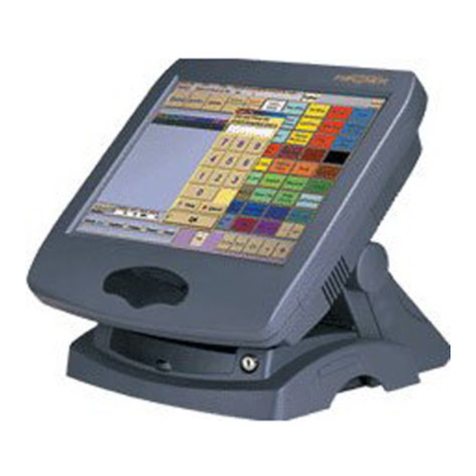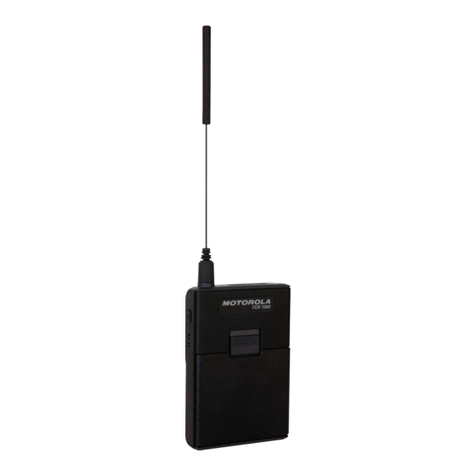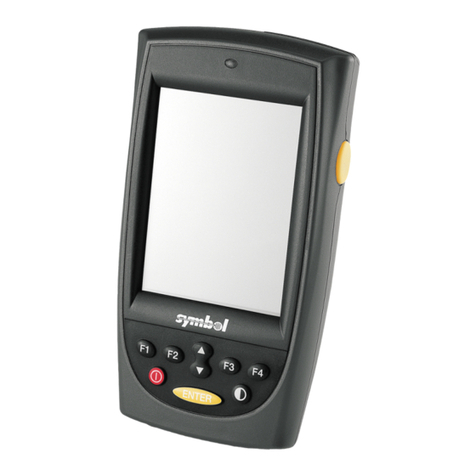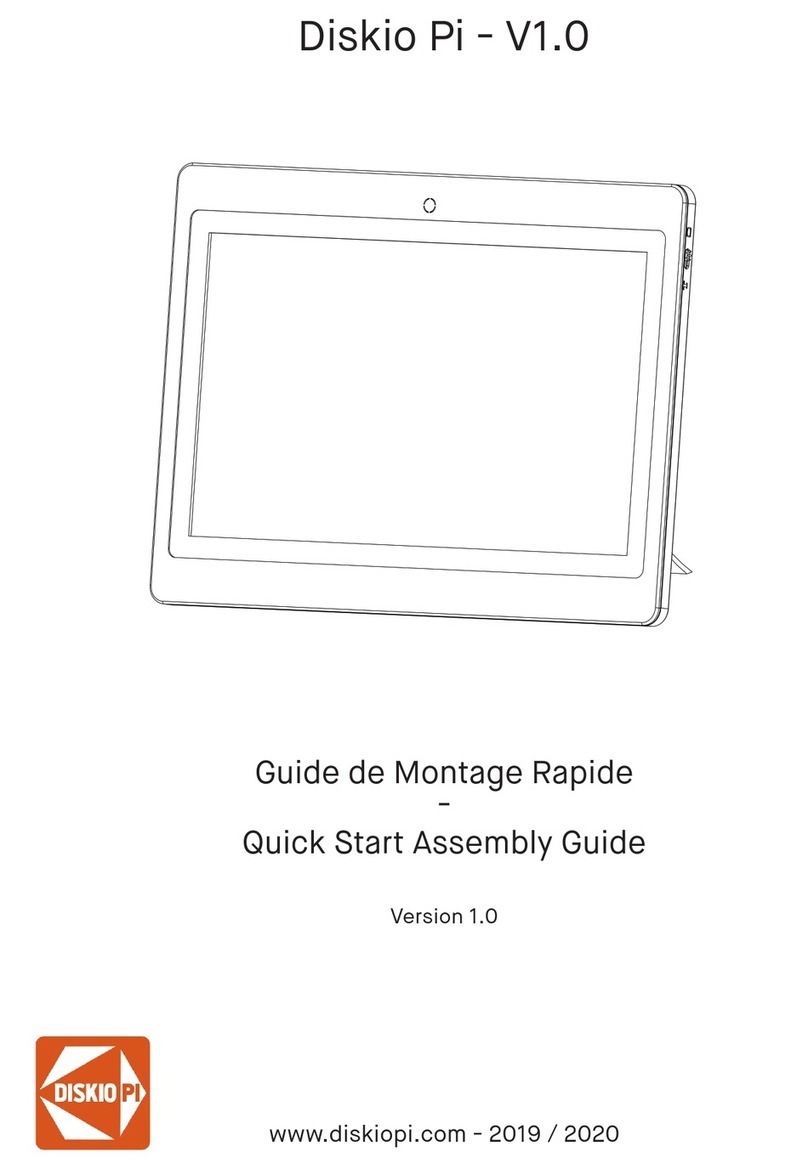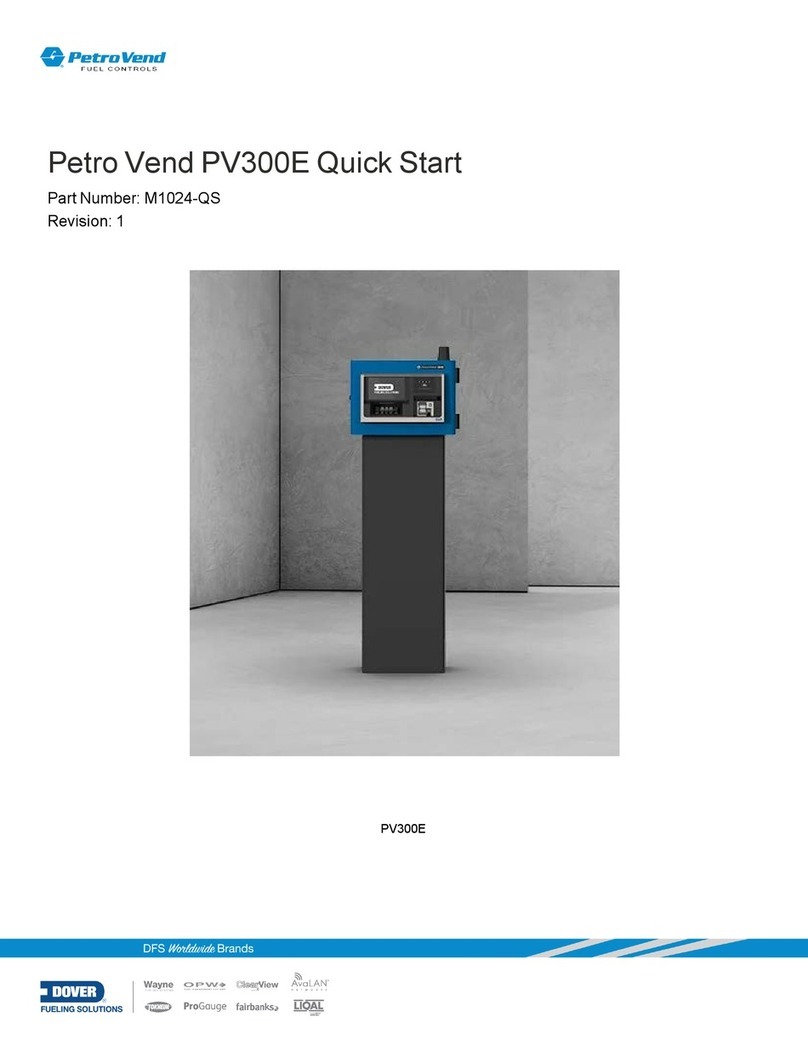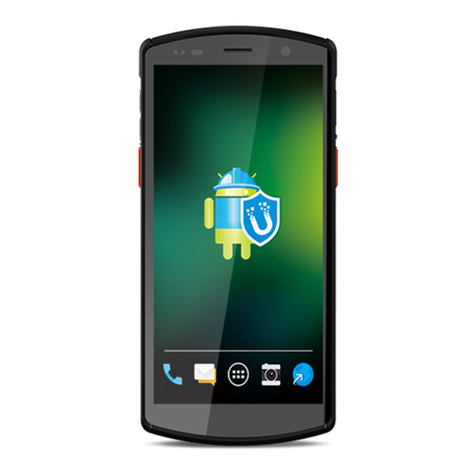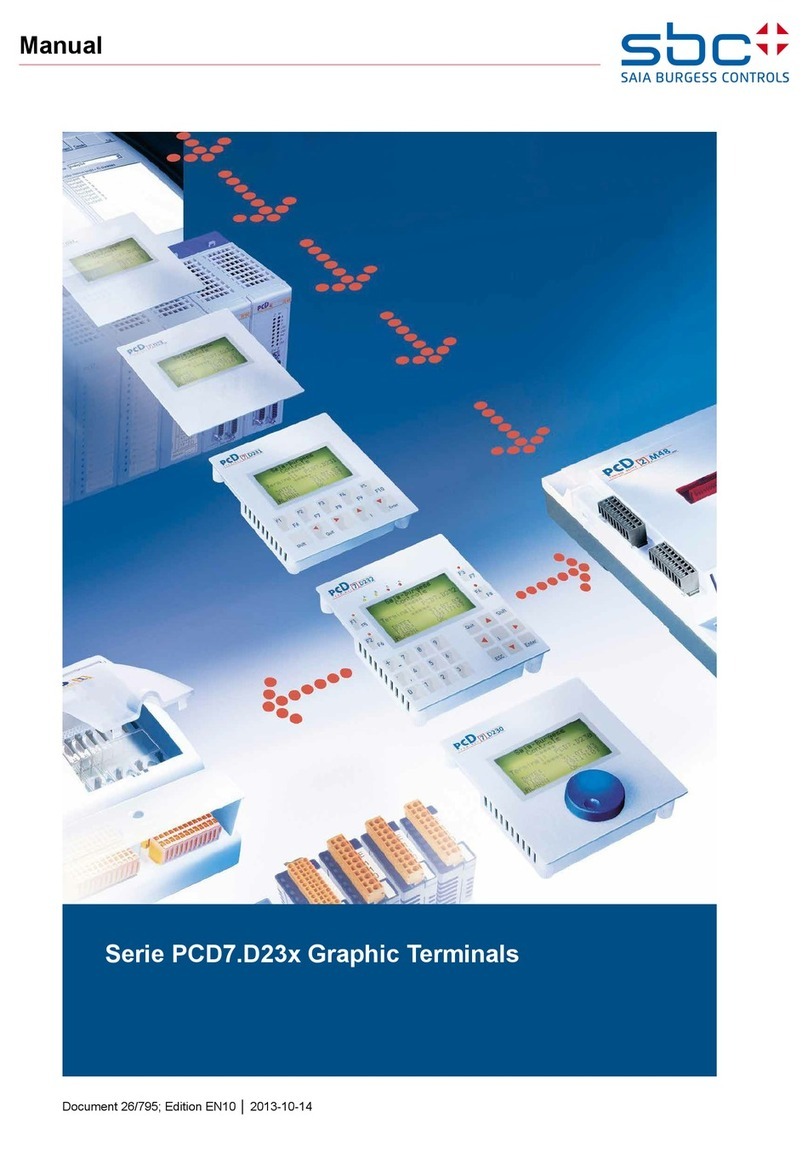Pro-face GLC2300-LG41-24V User manual

-15-
When Designing your GLC System:
- Be sure to design your GLC control system so that in the event of
a main power supply failure or a GLC accident, the user system’s
overall safety integrity will be maintained. If this is not done, in-
correct output signals or a GLC malfunction may cause an acci-
dent.
(1) Interlock circuits, etc. designed to interrupt or oppose normal
machine movement (i.e. Emergency Stop, General Protection,
forward and reverse rotation, etc.), as well as those designed
to prevent machine damage (i.e. for upper, lower and traverse
movement limit positioning, etc.) should all be designed to be
located outside of the GLC.
(2) Whenever the GLC generates a “Watchdog Timer Error”, GLC
operation will halt. Also, when errors occur in Input/Output
control areas that the GLC cannot detect, it is possible for
unexpected movement to occur in those areas. As a result,
for the purpose of preventing unsafe machine movement, a
“Failsafe Circuit” should be created which is completely ex-
ternal to the GLC.
(3) If a problem arises with an external unit’s relay or transistor,
causing an output (coil) to remain either ON or OFF, a major
accident can occur. To prevent this, be sure to set up external
watchdog circuits that will monitor vital output signals.
- Be sure to design a circuit that will supply power to the GLC’s I/O
unit before starting up the GLC. If the GLC’s internal program
enters RUN mode prior to the I/O unit’s load control power turn-
ing ON, an incorrect output (signal) or malfunction could cause
an accident to occur.
- Be sure to design a program that will ensure the safety of the
user’s system, in the event of a GLC display or control error, or in
the event of either a data transmission error or power failure be-
tween the GLC and a connected unit. These types of problems
can lead to an incorrect output (signal) or malfunction, which could
thereby cause an accident to occur.
-
Do not create GLC touch panel switches that could possibly en-
danger the safety of equipment and personnel. Damage to the GLC,
its I/O unit(s), cable(s), and other related equipment can cause an
output signal to remain continuously ON or OFF and possibly cause
a major accident. Therefore, design all monitoring circuits using
limit switches, etc. to detect incorrect device movement. To pre-
vent accidents related to incorrect signal output or operation, de-
sign all switches used to control vital machine operations so they
are operated via a separate control system.
DANGERS

-16-
- Do not use the GLC unit as a warning device for critical alarms
that can cause serious operator injury, machine damage or pro-
duction stoppage. Critical alarm indicators and their control/acti-
vator units must be designed using stand-alone hardware and/or
mechanical interlocks.
- Do not use GLC touch panel switches to perform operator safety-
related or important accident prevention operations. These op-
erations should be performed by separate hardware switches to
prevent operator injury and machine damage.
- Be sure to design your system so that equipment will not mal-
function due to a communication fault between the GLC and its
host controller. This is to prevent any possibility of bodily injury
or material damage.
- The GLC is not appropriate for use with aircraft control devices
or medical life support equipment, central trunk data transmis-
sion (communication) devices, nuclear power control devices, or
medical life support equipment, due to these devices inherent
requirements of extremely high levels of safety and reliability.
- When using the GLC with transportation vehicles (trains, cars
and ships), disaster and crime prevention devices, various types
of safety equipment, non-life support related medical devices, etc.
redundant and/or failsafe system designs should be used to en-
sure the proper degree of reliability and safety.
WARNINGS
Touch Panel Warnings:
After the GLC's backlight burns out, unlike the GLC's "Standby
Mode", the touch panel is still active. If the operator fails to no-
tice that the backlight is burned out and touches the panel, a po-
tentially dangerous machine operation error can occur.
1) If your GLC is not set to " Standby Mode" and the screen has
gone blank, your backlight is burned out.
2)
If your GLC is set to Standby Mode and touching the screen does
not cause the display to reappear, your backlight is burned out.
Also, to prevent an accidental machine operation error, Pro-face
suggests you use the GLC's built-in "USE TOUCH PANEL AFTER
BACKLIGHT BURNOUT" feature, that will automatically detect a
burnout and disable the touch screen.
Installation Warnings:
- High voltage current runs through the GLC. Except for replacing
the backlight, never disassemble the GLC, otherwise an electric
shock can occur.
DANGERS

-17-
- Do not modify the GLC unit. Doing so may cause a fire or an
electric shock.
- Do not use the GLC in an environment where flammable gasses
are present, since operating the GLC may cause an explosion.
Wiring Warnings:
- To prevent electric shock or equipment damage, prior to install-
ing or wiring the GLC, confirm that the GLC’s power cord is un-
plugged from the power supply.
- After completing any GLC wiring work, be sure the terminal block’s
protective plastic cover is reattached. If this cover is not reat-
tached, an electric shock could easily occur.
- Do not use power levels with the GLC that are outside of the
GLC’s specified power range. Doing so may cause a fire, electric
shock or damage the GLC.
- Do not operate or store the GLC in areas where flammable gas-
ses are present, since operating the GLC may cause an explo-
sion.
Operation and Maintenance Warnings:
- Do not touch a live power terminal. This could cause a shock or
machine malfunction.
- Due to the danger of an electric shock, confirm that the GLC’s
power cord is unplugged before either cleaning the GLC or at-
taching/detaching the power terminal block screws.
- When replacing the GLC’s backlight, be sure to unplug the unit’s
power cord to prevent a shock, and wear gloves to prevent being
burned.
- The GLC uses a lithium battery for backing up its internal clock
and control memory data. If the battery is incorrectly replaced
(i.e. the + and - sides are reversed), the battery may explode. There-
fore, before changing the battery, Pro-face recommends that you
contact your local GLC distributor for battery replacement instruc-
tions.
- Do not attempt to modify the GLC’s internal parts or wiring in any
way, since this may lead to either a shock or fire.
CAUTIONS
Wiring Layout Cautions:
- Be sure that all GLC input/output signal lines are isolated from all
power wiring or power cables, via a separate wiring duct. This is
to prevent excessive noise, which can cause a unit malfunction.
Installation Cautions:
- Be sure any data cable attached to a GLC connector is securely
attached. If the cable and connector pins do not all make com-
plete contact, incorrect input or output signals can result.e noise,
which can cause a unit malfunction.

-18-
- The GLC must be used as a built-in component of an end-use
product.
- The GLC should be installed in the front face of a metal panel.
- If the GLC is installed so as to cool itself naturally, be sure to
install it in a vertical panel.
General Wiring Cautions:
- To prevent shocks or malfunctions, the GLC’s FG (earth) wire
should be grounded according to the following:
1) A maximum grounding resistance of 100ΩΩ
ΩΩ
Ωor less.
2) A grounding wire of 2mm2or larger should be used.
- The GLC’s wiring should be checked to confirm both that the
operating voltage and wiring terminal locations are correct. If ei-
ther the voltage or the wiring terminal locations are incorrect, it
can cause a fire or accident.
- Be sure to secure all wiring terminal screws in place with the
designated torque. Screws and terminals that become loose can
cause a short circuit, fire or accident.
- Be sure that metal filings or wiring remnants do not fall inside the
GLC, since they can cause a fire, accident, or malfunction.
GLC Operation and Maintenance Cautions:
- Be sure to read the GLC’s manual and on-line help information
carefully before performing program changes, forced output, or
utilizing the RUN, STOP, PAUSE, Enable I/O and other commands
while the GLC is in operation. Mistakes concerning the use of
these items can cause a machine accident or damage.
- The liquid crystal panel contains a powerful irritant and if for any
reason the panel is damaged and this liquid enters your eye, flush
your eye for 15 minutes with running water and contact a physcian.
- Prior to inserting or removing a CF Card, be sure to turn the GLC's
CF Card ACCESS switch OFF and to confirm that the ACCESS
lamp is not lit. If you do not, CF Card internal data may be dam-
aged or lost.
- Do not turn OFF or reset the GLC while a CF Card is being ac-
cessed or insert or remove the CF Card. Prior to performing these
operations, create and use a special GLC application screen that
will prevent access to the CF Card.
GLC Unit Disposal Cautions:
- Be sure to dispose of the GLC unit in a manner appropriate to
your country’s industrial machinery disposal standards.

-19-
UL/c-UL(CSA)Approval
CE Marking
The GLC2300-LG41-24V/GLC2300-TC41-24V units are UL/c-UL(CSA)recog-
nized components. UL file no. E231702 (UL60950+UL1604)
When applying for UL approval for a product that includes one of these GLC units,
please be sure to pay special attention to the fact that all products with built-in GLC
units require UL inspection of the combination of the GLC and the product.
The GLC components conform to the following standards:
- UL1604 and UL60950 Third Edition
Safety of Information Technology Equipment for use in Class I and II, Division 2,
and Class III Hazardous (classified) locations.
- CAN/CSA-C22.2 No.60950-00 and No.213-M1987
Safety of Information Technology Equipment for use in Class I and II, Division 2,
and Class III Hazardous (classified) locations.
GLC2300-LG41-24V (UL Registration Model: 2980070-11)
GLC2300-TC41-24V (UL Registration Model: 2980070-12)
Installation Precautions
If the GLC is mounted so as to cool itself naturally, please mount it on a vertical
panel. Also, insure that the GLC is mounted at least 100 mm away from any other
adjacent structures or machine parts. If these conditions are not met, the heat gener-
ated by the GLC's internal components may cause it to fail to meet UL standards.
UL1604 - Compliance and Handling Cautions
1. Power and input/output wiring must be in accordance with Class I, Division 2
wiring methods - Article 501-4(b)of the National Electrical Code, NFPA 70
within the United States, and in accordance with Section 18-152 of the Canadian
Electrical Code for units installed within Canada.
2. Suitable for use in Class I, Division 2, Groups A, B, C, and D Hazardous Loca-
tions.
3. WARNING: Explosion hazard - substitution of components may impair com-
pliance to Class I, Division 2.
4. WARNING: Explosion hazard - when in hazardous locations, turn the power
OFF before replacing or wiring modules.
5. WARNING: Explosion hazard - confirm that the power supply has been turned
OFF before disconnecting equipment, or
confirm that the location is not subject to the
risk of explosion.
The GLC2300-LG41-24V/GLC2300-TC41-24V units are CE marked, EMC compliant
products. These units also conform to EN55011 Class A, EN61000-6-2 directives. For
detailed CE marking information, please contact your local GLC distributor.

-20-
The following items are included in the GLC's package. Before using the
GLC, please confirm that all items shown here are present.
This unit has been carefully packed, with special attention to quality.
However, should you find anything damaged or missing, please contact
your local GLC distributor immediately.
GLC Unit (1)
(GLC2300-LG41-24V/
GLC2300-TC41-24V)
Installation Guide (1)
<This Guide>
Installation Fasteners (4)
Package Contents
Installation
Guide
Installation Gasket (1)
Screw Lock Terminal Block (1)

-21-
A : Display
B : Touch Panel
C : Status LED
1Part Names
Color Indicator Operation
Mode*1 Controller
Operation Mode*2
Green ON OFFLINE --- *3
ON In operation RUN
Flashing In operation STOP
Red ON In operation MajorError
Color Indicator
Orange ON Meaning
Backlightburnouthasoccurred.
*1 Operation mode includes Display, SIO Com-
munication and touch key features.
*2 Includes the performance of ladder circuit
program features.
*3 Changing to OFFLINE will release and stop
ladder circuit program features.
Front
Rear
Bottom
D : Power Input Terminal Block
E : Expansion Unit Interface
F : CF Card Access LED
G : Serial Interface (Dsub 25-pin)
H : Tool Connector
I : Expansion Serial Interface
(Dsub 9-pin)
J : Screw Lock Terminal Block
(6-pin)
K : Flex Network Status LED
Inside the CF Cover
N
M
L
J
I
H
G
E
FD
A,B
C
Right Side Left Side
K
L : Ethernet Interface
M : CF Card Cover
N : CF Card Slot (inside cover)
a
b
LED Status Contents
a:RUN
(GREEN) Turns on when comm-
unication is enabled.
b:ERR
(RED)
Turns on when failure
occursin connected I/O
Unit.

-22-
These switches are located inside the CF Card's cover.
Dip Switch Function ON OFF Note
1
This Dip switch
setting controls the
startup from a CF
Card.
Startup from CF
Card is enabled. Startup from CF
Card is
disabled.
CF Card with startup
data required.
2Reserved Always OFF
3Reserved Always OFF
4This setting controls
the forced closing of
the CF Card cover.
Forced close
enabled. Forced close
disabled. Used when CF Card
cover is damaged.
3CF Card Dip Switches
Dip Switches
(factory set)
Bottom of GLC
Unit:mm [in.]
Top
SideFront
60 [2.36]
5 [0.20]
123 [4.84]
138 [5.43]
155.5 [6.12]
171 [6.73]
2Dimensions

-23-
Pin Arrangement Pin # Signal
Name Condition
1 FG FrameGround
2 SD Send Data (RS-232C)
3 RD ReceiveData(RS-232C)
4 RS Requestto Send (RS-232C)
5 CS Clearto Send (RS-232C)
6 DR DataSetReady(RS-232C)
7 SG SignalGround
8 CD CarrierDetect(RS-232C)
9 TRMX Termination (RS-422)
10 RDA Receive Data A(RS-422)
11 SDA Send DataA(RS-422)
12 NC NotConnected(Reserved)
13 NC NotConnected(Reserved)
14 VCC 5V±5%Output0.25A
15 SDB Send DataB(RS-422)
16 RDB Receive Data B(RS-422)
17 RI Ring Indicate (RS-232C)
18 CSB Clear to Send B (RS-422)
19 ERB Enable ReceiveB(RS-422)
20 ER EnableReceive(RS-232C)
21 CSA Clear to Send A (RS-422)
22 ERA Enable ReceiveA(RS-422)
23 NC NotConnected(Reserved)
24 NC NotConnected(Reserved)
25 NC NotConnected(Reserved)
Serial Interface
4Interfaces
Recommended Connector : Dsub 25-pin plug XM2A-2501 <made by OMRON Corp.>
Recommended Cover : Dsub 25-pin Cover XM2S-2511 <made by OMRON Corp.>
Recommended Cover : Dsub 25-pin Cover XM2S-2521 <made by OMRON Corp.>
Recommended Screw : Jack Screw XM2Z-0071 <made by OMRON Corp.>
Recommended Cable : CO-MA-VV-SB5P x 28AWG <made by HITACHI Cable Ltd.>
• This GLC unit’s serial port is not isolated. When the host (PLC) unit is
also not isolated, and to reduce the risk of damaging the RS-422 circuit,
be sure to connect the #7 SG (Signal Ground) terminal.
• Pin #14 (VCC) DC 5V Output is not protected. To prevent damage or unit
malfunction, use only the designated level of current.
• Inside the GLC unit, the SG (Signal Ground) and FG (Frame Ground)
terminals are connected to each other.
• When connecting an external device to the GLC with the SG terminal,
ensure that no short-circuit loop is created when you setup the system.
114
13 25
This interface is used to connect the GLC to the host (PLC), via an RS-232C
or RS-422 cable. The connector used is a socket-type connector.

-24-
• Use rough metric type M2.6 x 0.45p threads to hold the cable’s set (fasten-
ing) screws in place.
• For RS-422 Connectors
• The following pairs of pin numbers must be connected (shorted).
...#18 (CSB) <-> #19 (ERB)
...#21 (CSA) <-> #22 (ERA)
• Connecting the #9 (TRMX) and #10 (RDA) wires, adds a termination
resistance of 100ΩΩ
ΩΩ
Ωbetween RDA and RDB.
• Use a 4-wire cable when the PLC type is Memory Link and the cable is
RS-422.
• For RS-232C Connectors
• Do not connect #9 (TRMX), #10 (RDA), #11 (SDA), #15 (SDB), #16 (RDB),
#18 (CSB), #19 (ERB), #21 (CSA), and #22 (ERA).
• Connect the #1 (FG) terminal only if it is required by a connected device.
Expansion Serial Interface
Connect a Serial Bar-code reader or a 2-Dimensional-code reader to this
interface.The connector used is a plug-type connector.
Pin Arrangement Pin # Signal Name Description
1 CD Carrier Detect(RS-232C)
2 RD Receive Data(RS-232C)
3 SD Send Data(RS-232C)
4 ER Enable Receive(RS-232C)
5 SG Signal Ground
6 DR Data SetReady(RS-232C)
7 RS Requestto Send(RS-232C)
8 CS Clear to Send(RS-232C)
9 RI/VCC Ring Indicate(RS-232C) 5V±5%0.25A
Recommended Connector :Dsub 9-pin socket XM2D-0901 <made by OMRON Corp.>
Recommended Cover :Dsub 9-pin cover XM2S-0913 <made by OMRON Corp.>
Recommended Screw :Jack Screw XM2Z-0073 <made by OMRON Corp.>
Use inch type screws (#4-40UNC) as set screws.
59
16
Since Pin#9(RI/VCC) is unprotected, be sure to keep the out-
put current within the rated range.
Screw Lock Terminal Block
This interface is used for Flex Network connections.
Pin Arrangement Pin No. Signal Name Description
1 TR+ CH1 Comunication Data
2 TR- CH1 Comunication Data
3 SLD CH1 Cable, Shield
4 TR+ CH2 Comunication Data
5 TR- CH2 Comunication Data
6 SLD CH2 Cable, Shield
16

-25-
156.0 [6.14 ]
Expansion Unit Interface
This interface is used to connect an expansion unit that can transmit data over
a Fieldbus or similar type of network.
Tool Connector
Connects a Data Transfer Cable or bar code reader.
Connect the GLC to a serial printer via the Data Transfer Cable and
a User-created conversion cable.
GLC2300 Series User Manual
Ethernet Interface
This interface complies with the IEEE802.3 standard for Ethernet (10BASE-T)
connections. This interface uses an RJ-45 type modular jack (8 points).
CF Card Interface
This slot accepts a CF Card.
• Before installing the GLC into a cabinet or panel, check that
the installation gasket is securely attached to the unit.
• A gasket which has been used for a long period of time may
have scratches or dirt on it, and could have lost much of its
dust and drip resistance. Be sure to change the gasket peri-
odically (or when scratches or dirt become visible).
Confirm the Installation Gasket's Positioning
It is strongly recommended that you use the gasket. It absorbs vibration in
addition to repelling moisture.
Place the GLC on a level surface with the display panel facing downward.
Check that the GLC’s installation gasket is seated securely into the gasket’s
groove, which runs around the perimeter of the panel’s frame.
5Installation
Gasket
Rear face
Create a Panel Cut and insert the GLC into the panel from the front
Unit: mm [in]
+1
0 +0.04
0
under 4-R3
Panel Panel thickness:
1.6mm[0.06in] to
5.0mm[0.20in]
GLC
Panel
123.5 [4.86 ]
+0.04
0
+1
0

-26-
Attach the Installation Fasteners from Inside the Panel
The following figures show the four (4) fastener insertion slot locations. In-
sert each fastener's hook into the slot and tighten it with a screwdriver.
Installation
fastener
Panel
GLC
Insertion Slots Insertion Slots
Top Bottom
• Tightening the screws with too much force can damage the GP's
plastic case.
• The necessary torque is 0.5 N•m.
• Depending on the installation panel's thickness, etc., the number of
installation fasteners used may need to be increased to provide the
desired level of moisture resistance.

-27-
• To avoid a short caused by loose ring terminals, be sure to use ring
terminals with an insulating sleeve. *1
• When the FG terminal is connected, be sure the wire is grounded. Not
grounding the GLC unit will result in excess noise and vibration.
• The SG and FG terminals are connected internally in the GLC unit.
• When connecting the SG line to another device, be sure that the de-
sign of the system/connection does not produce a shorting loop.
• Wherever possible, use thick wires (max. 2 mm2) for power terminals, and
twist the wire ends before attaching the ring terminals.
• Be sure to use the following size ring terminals.
Connecting the GLC Power Cord
When connecting the power cord, be sure to follow the procedures given
below.
1. Confirm that the GLC's Power Cord is unplugged from the power supply.
2. Use a screwdriver to remove the Power Input Terminal Block's clear plastic
cover.
3. Unscrew the screws from the middle three (3) terminals, align the Ring
Terminals and re-attach the screws.
4. Replace the Power Input Terminal Block's clear plastic cover.
• Confirm that the ring wires are connected correctly.
• The torque required to tighten these screws is 0.5 to 0.6 N•m.
*1 Suggested Ring Terminal : V2-MS3 (made by JST)
•To avoid an electric shock, prior to connecting the GLC's power cord
terminals to the power terminal block, confirm that the GLC's power
supply is completely turned OFF, via a breaker, or similar unit.
•The GLC2300-LG41-24V/GLC2300-TC41-24V units are designed
to use only DC24V input. Any other power level can damage both
the GLC and the power supply.
•Since there is no power switch on the GLC unit, be sure to attach
a breaker type switch to its power cord.
• When the FG terminal is connected, be sure the wire is grounded.
6Wiring
WARNINGS
Power Input
Terminal Block
Ring Terminals*1Rear of GLC

-28-
• When attaching a wire to the GLC's rear face FG terminal, (on the Power Input
Terminal Block), be sure to create an exclusive ground.
• Inside the GLC2300-LG41-24V/GLC2300-TC41-24V units, the SG(Signal Ground)
and FG(Frame Ground) terminals are connected to each other.
• When connecting the SG line to another device, be sure that the design of the sys-
tem/connection does not produce a shorting loop.
• When attaching an expansion unit to the GLC, be sure to read the expansion unit's
Installation Guide.
Please pay special attention to the following instructions when connecting the power
cord terminals to the GLC unit.
•If the power supply voltage exceeds the GLC's specified range, connect a voltage
transformer.
•Between the line and the ground, be sure to use a low noise power supply. If there is still
an excessive amount of noise, connect a noise reducing transformer.
•Input and Output signal lines must be separated from the power control cables for
operational circuits.
•To increase the noise resistance, be sure to twist the ends of the power cord wires
before connecting it to the GLC unit.
•The GLC's power supply cord should not be bundled with or kept close to main
circuit lines (high voltage, high current), or input/output signal lines.
•Connect a surge absorber to handle power surges.
•To reduce noise, make the power cord as short as possible.
•Depending on the input voltage and operating temperature, an incorrectly detected
backlight failure error may occur when power is switched ON, especially at low
temperatures. Be sure the Backlight Failure Detection feature is used only in the
following conditions:
•All GLC Input and Output signal lines must be separated from all operating circuit
(power) cables.
•If this is not possible, use a shielded cable and ground the shield.
9Input/Output Signal Line Cautions
8Grounding Cautions
7Power Supply Cautions
The GLC2300-LG41-24V unit's backlight is user replacable.
For an explanation of how to replace the GLC's backlight, please refer to the Back-
light Replacement Guide included with the replacement backlights (sold separately).
10 Replacing the Backlight
Do not use of a different model backlight, since it may cause a GLC
malfunction or breakdown.
GLC Unit Required Backlight Model
GLC2300-LG41-24V PS300-BU00
The GLC2300-TC41-24V unit's backlight cannot be changed by the User.
To request replacement service, please contact your local GLC distributor.
If the Operating Temperature is… The Input Voltage must be…
0oC to 10oC DC24.0V to DC28.8V
10oC to 50oC DC19.2V to DC28.8V
This manual suits for next models
1
Table of contents
Other Pro-face Touch Terminal manuals

Pro-face
Pro-face GLC100-LG41-24V User manual

Pro-face
Pro-face GP2501-TC41-24V User manual

Pro-face
Pro-face GP2501-LG41-24V User manual
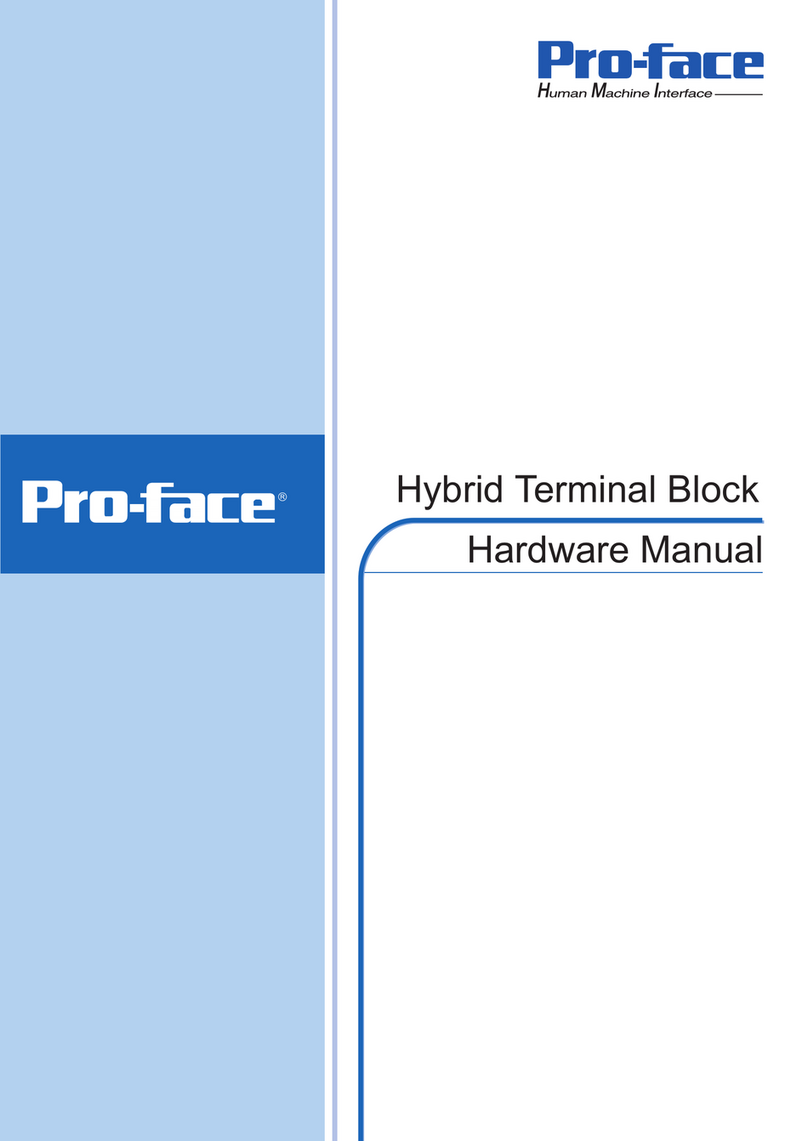
Pro-face
Pro-face HTB User manual

Pro-face
Pro-face GP2500-TC41-24V User manual

Pro-face
Pro-face FP2500-T42-24V User manual

Pro-face
Pro-face GP2301H-LG41-24V User manual

Pro-face
Pro-face AST-3501T User manual
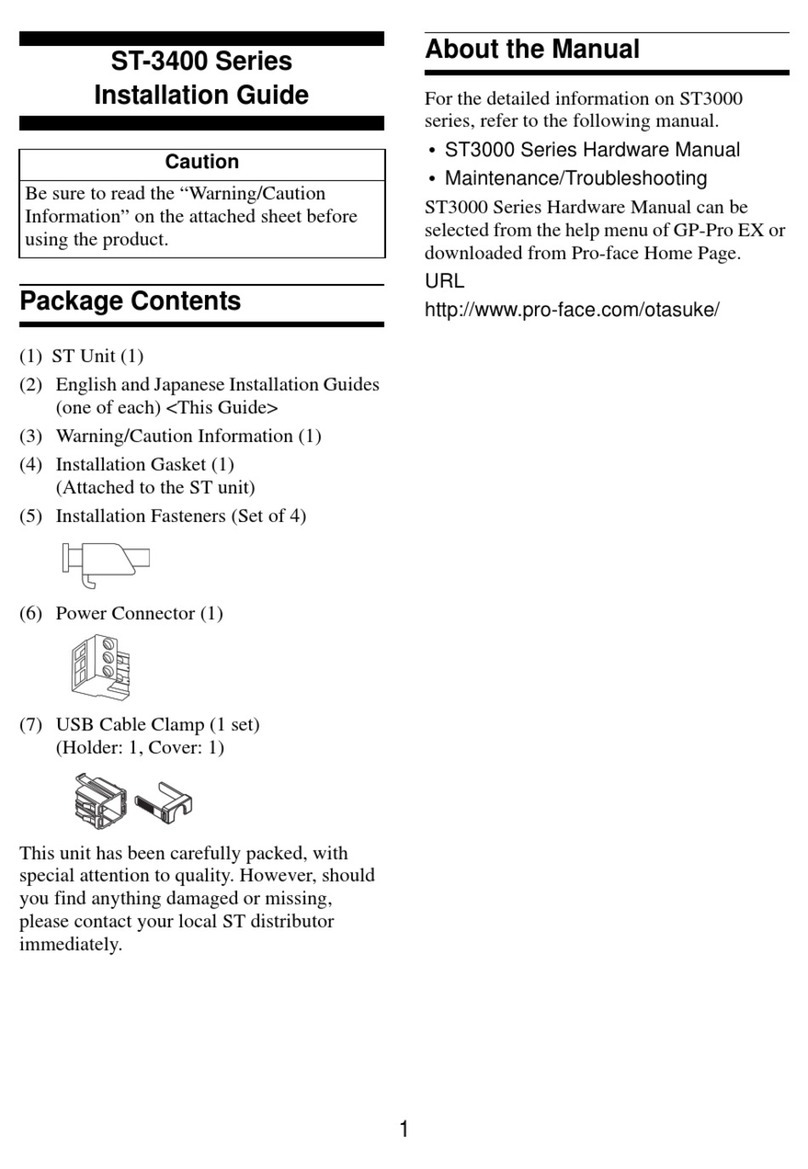
Pro-face
Pro-face ST-3400 Series User manual
